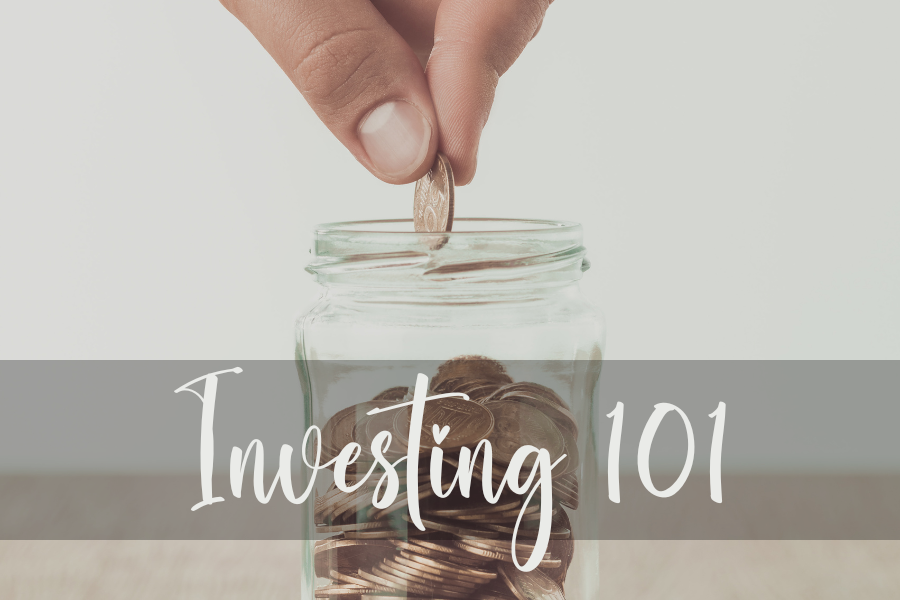This article may contain affiliate links. See our disclaimer for more information.

Are you new to investing and looking for guidance on where to start? Look no further than this beginner’s guide to investing, also known as Investing 101. Investing can seem intimidating at first, but with some basic knowledge of investing basics, you can make informed decisions and start building your wealth.
Why Investing is Important for Financial Growth

If you’re looking to build a solid financial foundation, investing should be a part of your strategy. Unlike traditional saving methods that offer limited returns, investing has the power to generate higher returns over time. One key advantage of investing is compound interest, which enables your money to grow exponentially as you earn returns on your initial investment, as well as on the interest earned.
What I want to teach you in investing 101 is that by taking a proactive approach to investing, you can reap the benefits of these returns to achieve long-term financial growth. However, investing can be overwhelming for beginners, which is why it’s important to equip yourself with the right investment tips and strategies. With the proper investment education, you should be able to develop a personalized investment plan that aligns with your financial goals and risk tolerance.
Setting Financial Goals: The First Step to Successful Investing

Before investing, it’s vital to set clear financial goals. This will help create a roadmap for your investment journey and ensure you stay motivated and focused. When setting your goals, consider both short-term and long-term objectives. Short-term goals could include paying off debt or saving for a down payment on a home, while long-term goals could include retirement or a child’s college education.
Defining your goals is essential as they can have a significant impact on your investment strategy. For example, if you’re saving for a short-term goal, such as purchasing a car, you may want to invest in more conservative options to minimize risk. Alternatively, if you’re investing for a long-term goal, such as retirement, you may want to consider more aggressive options that have the potential for higher returns.
Take the time to write down your financial goals, update them regularly, and make sure they align with your personal values and circumstances. By setting clear financial goals, you’ll be better equipped to make informed investment decisions, and you’ll be one step closer to achieving financial success.
Understanding Different Investment Options

As a beginner investor, it’s important to have a comprehensive understanding of the various investment options available. Stocks, bonds, mutual funds, and real estate are just a few examples of the many investment opportunities you can explore. As part of investing 101, let’s break those down for you.
- Stocks: Buying a share of stock means you own a percentage of the company. This investment option offers the potential for high returns but can be risky.
- Bonds: A bond is essentially a loan you provide to a company or the government. Bonds typically offer a lower rate of return but present less risk than stocks.
- Mutual Funds: Mutual funds pool money from many investors to invest in a diversified portfolio of stocks, bonds, and other assets. This option allows for greater diversification and lower risk than investing in a single stock or bond.
- Real Estate: Investing in property can offer both income and appreciation potential. However, this option requires a significant amount of capital and presents its own unique set of risks.
By understanding the advantages and disadvantages of each investment option, you can make informed decisions and develop a well-rounded investment portfolio that aligns with your financial goals and risk tolerance.
Building a Diversified Investment Portfolio

As a beginner investor, one of the best strategies you can adopt is diversification. Diversification basically means that you spread your investments across different asset classes and sectors to reduce the risk of losing all your money in one place. It’s an investment strategy that can help you maximize potential returns while minimizing risk.
Here are some investing 101 tips to help you build a diversified investment portfolio:
- Invest in different asset classes: Consider investing in a mix of stocks, bonds, mutual funds, real estate, and other types of investments. This can help buffer your portfolio against market volatility.
- Invest in different sectors: When investing in stocks, for example, consider investing in a mix of different sectors such as technology, healthcare, and finance. This can help protect your portfolio if one sector performs poorly.
- Consider international investments: Investing in international markets can provide additional diversification benefits. Consider adding international stocks or mutual funds to your portfolio.
- Rebalance your portfolio regularly: As you add investments to your portfolio, it’s important to monitor it regularly and rebalance it as needed. This can help ensure that your portfolio remains diversified and aligned with your investment goals.
Remember, diversifying your investment portfolio does not guarantee profits or protection against losses, but it can help reduce risk and increase potential returns.
Assessing Risk Tolerance: Finding the Right Balance

Before diving into investing, you need to understand your risk tolerance. Every investor has different goals, financial situations, and comfort levels. Assessing risk tolerance is a crucial step in finding the right balance for your investment portfolio.
Investing fundamentals are centered around finding a balance between potential returns and risk. If you’re a beginner in investment, it’s essential to start slowly and cautiously. Lower risk investments are a better fit for those just starting out or who have a low-risk tolerance.
But opting for less risky investments often means lower returns. It isn’t suitable for everyone. Therefore, assessing your risk tolerance is essential. You want to find a balance that meets your goals while also satisfying your comfort level.
When assessing risk tolerance, ask yourself how much risk you’re willing to take to achieve your financial goals. Here are some of our favorite questions to get yourself started:
- What’s your investment time horizon?
- How much money are you willing to lose without panicking?
- How do you feel about risk?
- What are you investing for?
- What are your investing goals?
By answering these important questions you can find the right balance for your investing journey.
As part of investing 101, we want you to find a balance that aligns with your financial goals. It is a crucial foundation to start building your investment portfolio and reaching your financial goals.
Developing an Investment Strategy

When it comes to investing 101, developing a strategy tailored to your specific goals and risk tolerance is critical. One popular investment strategy is value investing, which involves finding companies that are undervalued by the market and have potential for long-term growth. Another approach is growth investing, where investors look for companies with high growth potential. I have some investments in retirement accounts, some in a crowdfunding real estate online platform called Fundrise, some money in my own real estate, and the rest in a mutual fund at Vanguard.
Regardless of the approach you choose, research and analysis are crucial to making informed investment decisions. Taking the time to evaluate a company’s financial health, management team, industry trends, and potential risks can help you make educated investment choices and mitigate potential losses.
It’s also important to regularly review and adjust your investment strategy as your goals and the market change. Keeping a well-diversified portfolio and staying disciplined in your investment decisions can help you achieve long-term financial success.
Monitoring and Adjusting Your Investments

As you continue your investment journey, it’s essential to monitor your investments to ensure they’re aligned with your financial goals. Regular monitoring can help you detect potential issues early and make informed decisions about when to buy, sell, or hold your investments.
It’s crucial to adjust your investment portfolio as the market changes. This will help you maintain a diversified portfolio and manage risk effectively. Rebalancing your portfolio annually can also ensure that you’re not overexposed to particular asset classes or market sectors.
You don’t need to monitor your investments every day or make frequent changes. It’s best to develop a sound investment strategy and stick to it. Regularly reviewing your investment portfolio and making necessary adjustments can help you achieve long-term financial growth. I tend to monitor mine monthly, and determine yearly if I need to do any readjusting.
Here are some investment tips to help you monitor and adjust your investments effectively:
- Set clear investment goals
- Identify your risk tolerance level
- Diversify your investment portfolio
- Regularly review your investment portfolio performance
- Keep track of your investment fees
- Stay informed with industry news and market updates
By following these investing principles and investing 101 tips, you can effectively monitor and adjust your investments to help you achieve your financial goals and ensure that you’re on the right track.
Common Mistakes to Avoid as a Beginner Investor

Investing can be overwhelming, especially as a beginner. As part of investing 101, we want you to avoid these common mistakes that can derail your investment journey.
- Emotional decision-making: Avoid making investment decisions based on emotions such as fear or excitement. Stick to your investment strategy and avoid impulsive decisions.
- Chasing short-term trends: Jumping on the latest investment trend can lead to significant losses. Instead, focus on building a diversified investment portfolio with a long-term view.
- Ignoring the importance of patience and discipline: Investment success takes time and requires discipline. Avoid the temptation to check your investments every day and remain patient in the face of market volatility.
Remember, investing for dummies doesn’t have to be complicated. With some investment education and a sound investment strategy, you can set yourself up for long-term financial success.
Conclusion

So there you have it – a comprehensive guide to investing 101 for beginners. I hope this article has provided you with a solid foundation to start your financial journey towards long-term growth and wealth. Remember, investing is an ongoing process, and it requires patience, discipline, and a willingness to learn and adapt.
As you embark on your investment journey, keep in mind the importance of setting clear financial goals, diversifying your investment portfolio, understanding your risk tolerance, and developing a solid investment strategy. It’s also crucial to stay informed, seek professional advice when necessary, and avoid common mistakes such as emotional decision-making and chasing short-term trends.
With these principles in mind, I have no doubt that you’ll be well on your way to achieving your financial goals. Always remember – the key to successful investing is staying the course, even during market turbulence and uncertainty. Happy investing!
Looking for more information? Check out our other article : Master the Basics: Stock Market for Beginners




